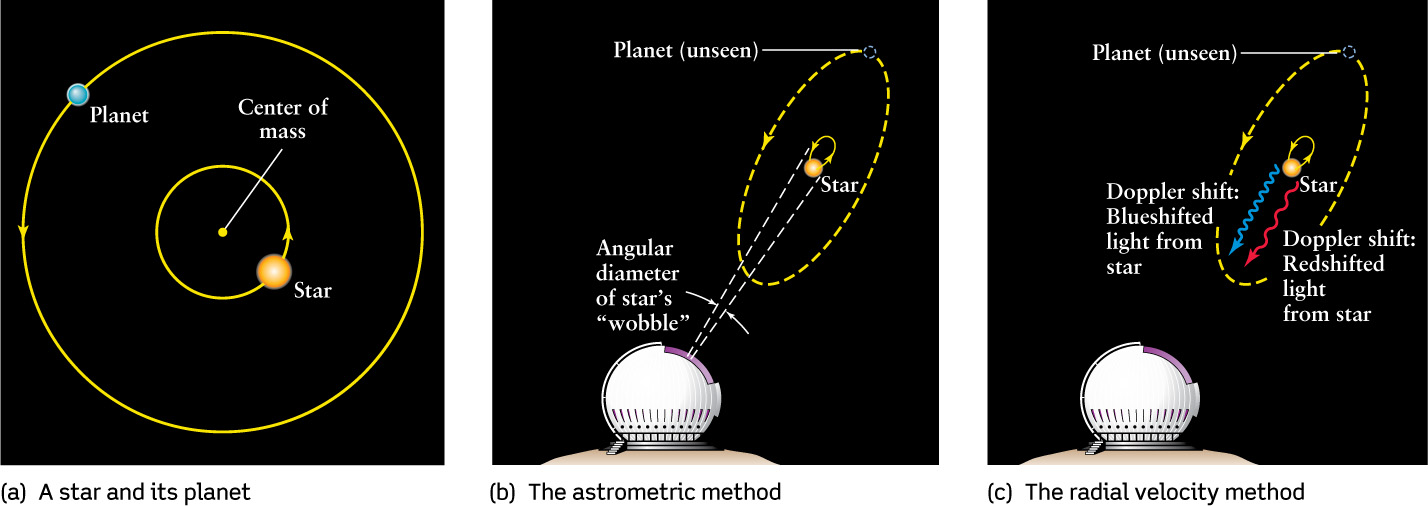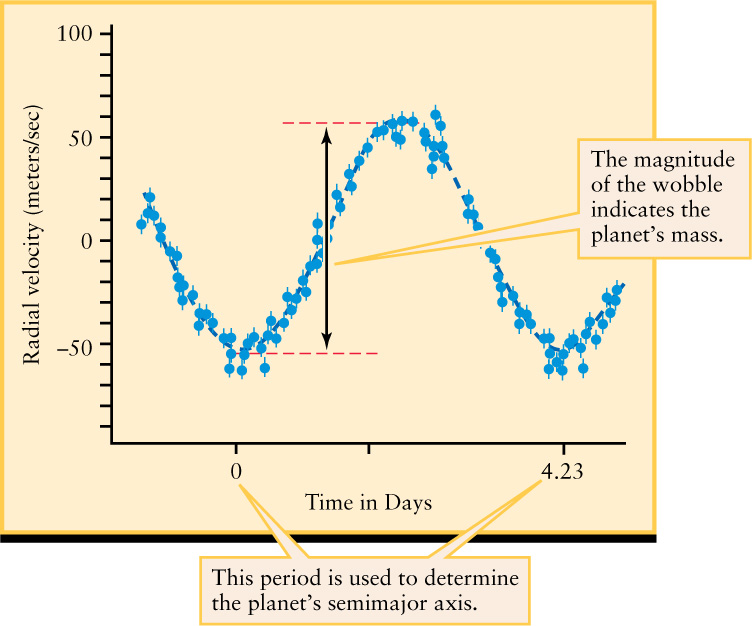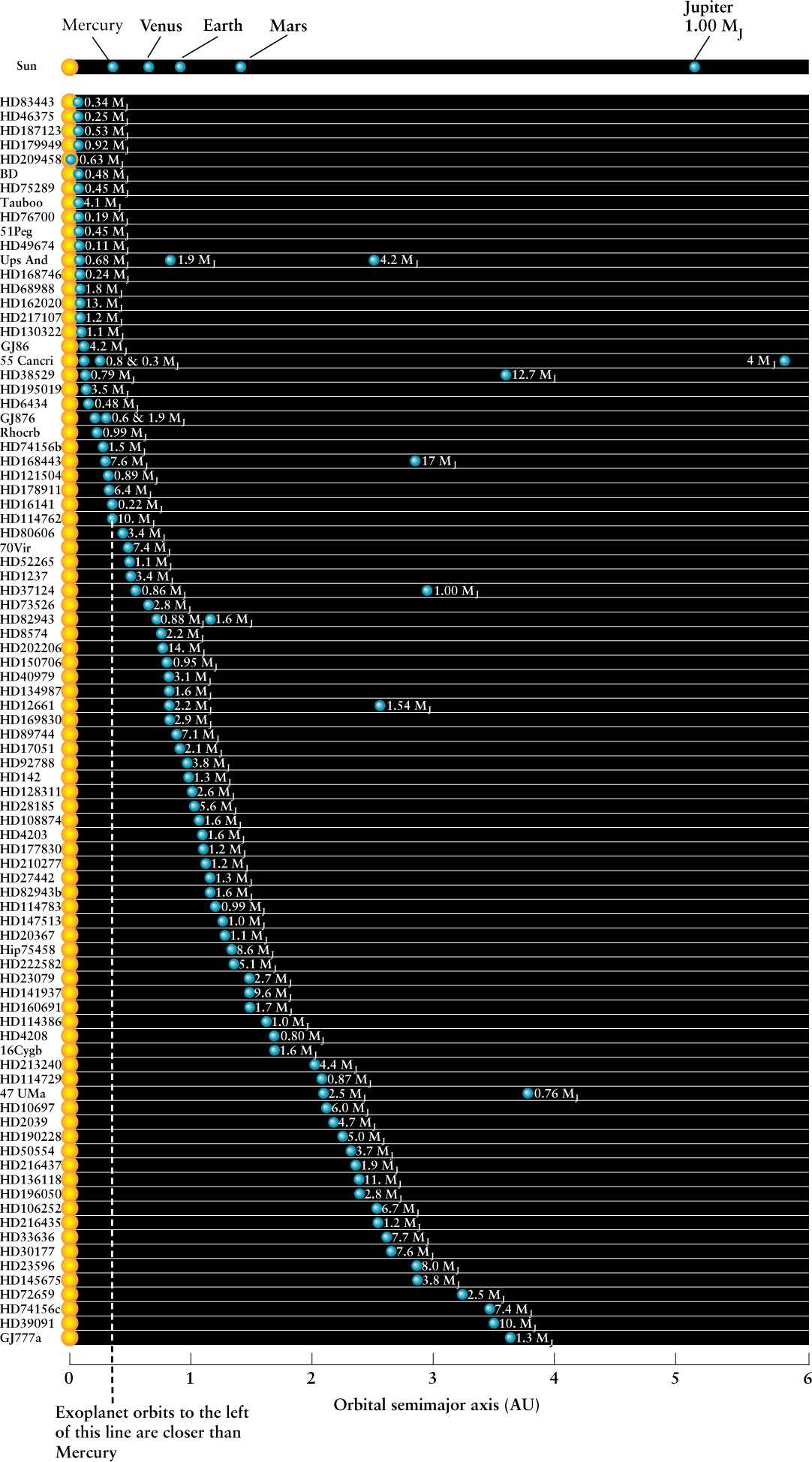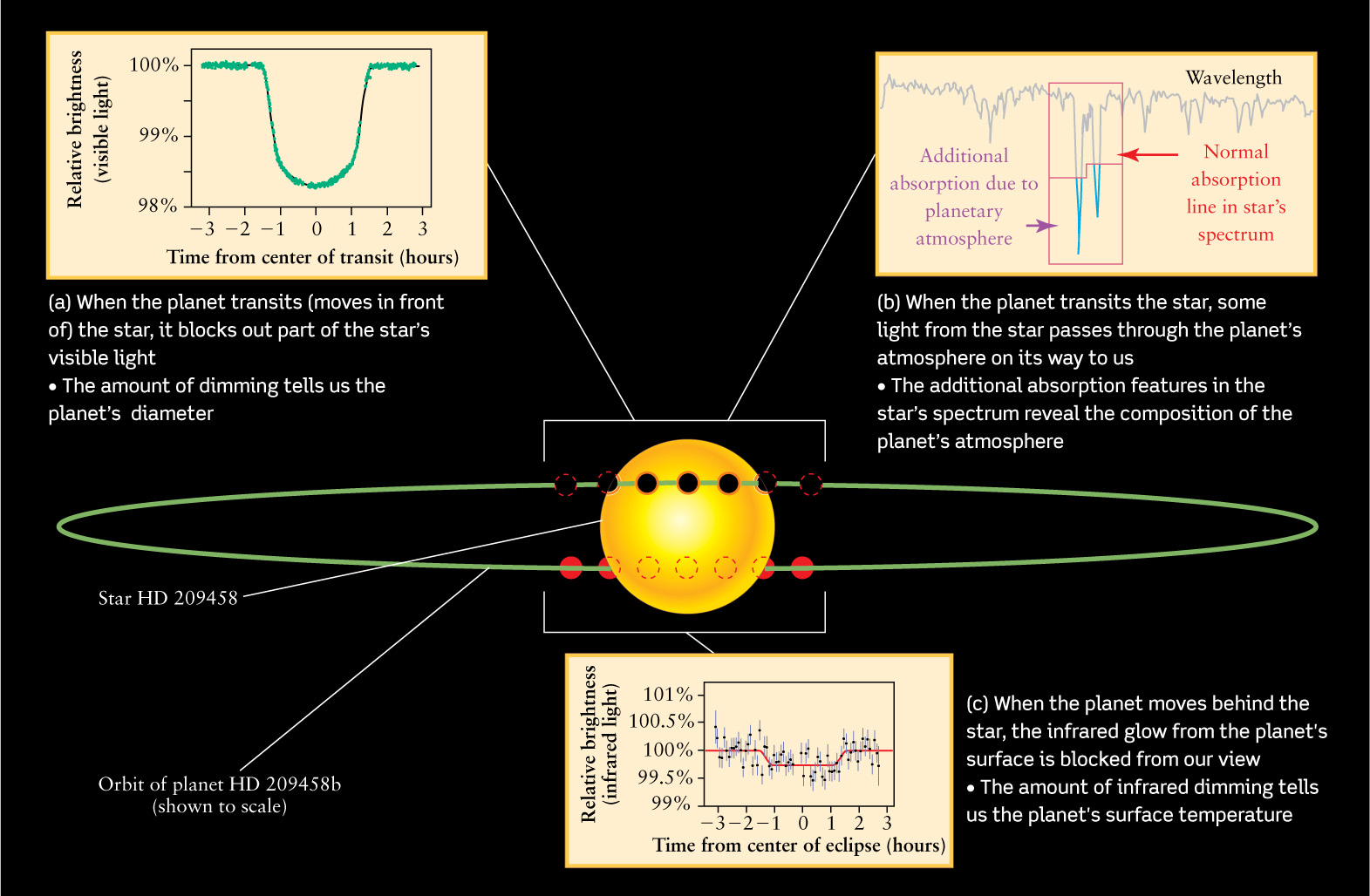8-7 A variety of observational techniques reveal planets around other stars
Many planets have been discovered around other stars, and some are Earth-size
If planets formed around our Sun, have they formed around other stars? The answer is yes, and they are called extrasolar planets, or exoplanets. The discovery of exoplanets brings up several questions that we will consider next. What are the properties of these exoplanets—are they similar to the planets of our solar system? What do they tell us about the formation of other solar systems? And perhaps the biggest question of all: Are there other Earthlike planets?
Since exoplanets were first detected in the 1990s, this field of astronomy has exploded with new discoveries. At the time of this writing, 834 exoplanets have been discovered with a wide range of properties, and some big surprises. (This number refers to confirmed exoplanets, and several thousand candidates are awaiting confirmation.) To appreciate how remarkable these discoveries are, we must look at the process that astronomers go through to search for exoplanets.
Searching for Exoplanets
It is very difficult to make direct observations of planets orbiting other stars. The problem is that planets are small and dim compared with stars; for example, the Sun is a billion times brighter than Jupiter at visible wavelengths. Exoplanets can be imaged directly, as in Figure 8-15a, but a star’s glare makes this method the least productive method of detection. By the time the exoplanets in Figure 8-15b were imaged in 2010, hundreds had been detected through other means. One very powerful method of exoplanet detection is to search for stars that appear to “wobble” (Figure 8-16). If a star has a planet, it is not quite correct to say that the planet orbits the star. Rather, both the planet and the star move in elliptical orbits around a point called the center of mass (Figure 8-16a). Imagine the planet and the star as sitting at opposite ends of a very long seesaw; the center of mass is where you would have to place the support-point (or fulcrum) in order to balance the seesaw. Because of the star’s much greater mass, the center of mass is much closer to the star than to the planet. Thus, while the planet may move in a very large orbit, the star will move in a much smaller orbit.

Imaging Extrasolar Planets (a) Four planets can be seen orbiting the star HR 8799. The star is about 129 light-years from Earth and can be seen with the naked eye on a clear night. In capturing this image, special techniques make the star less visible to reduce its glare and reveal its planets. The white arrows indicate possible trajectories that each star might take over the next ten years. (b) About 170 light-years away, the star 2M1207 and a planet with about 1.5 times the diameter of Jupiter are captured in this infrared image. First observed in 2004, this extrasolar planet was the first to be visible in a telescopic image. At infrared wavelengths a star outshines a Jupiter-sized planet by only about 100 to 1, compared to 109 to 1 at visible wavelengths, making imaging possible in the infrared.

As an example, the Sun and Jupiter both orbit their common center of mass with an orbital period of 11.86 years. (Jupiter has more mass than the other seven planets put together, so it is a reasonable approximation to consider the Sun’s wobble as being due to Jupiter alone.) The Sun’s orbit around the common center of mass has a semimajor axis only slightly greater than the Sun’s radius, so the Sun slowly wobbles around a point not far outside its surface. If astronomers elsewhere in the Galaxy could detect the Sun’s wobbling motion, they could tell that there was a large planet (Jupiter) orbiting the Sun. They could even determine the planet’s mass and the size of its orbit, even though the planet itself was unseen!
Detecting the wobble of other stars is not an easy task. One approach to the problem, called the astrometric method, involves making very precise measurements of a star’s position in the sky relative to other stars. The goal is to find stars whose positions change in a cyclic way (Figure 8-16b). The measurements must be made with very high accuracy (0.001 arcsec or better) and, ideally, over a long enough time to span an entire orbital period of the star’s motion. The direct observation of a star’s changing position has not yet played a significant role in detecting exoplanets, but as we will see, that will change in the near future.
 A star’s wobble can also be detected by the radial velocity method (Figure 8-16c). This method is based on the Doppler effect, which we described in Section 5-9. During repeated orbits, a wobbling star will alternately move toward and away from Earth. Only this motion along a radius or line between Earth and the star—in other words, the star’s radial velocity—contributes to the Doppler shift. The star’s movement causes the wavelengths of its entire spectrum to shift in a periodic fashion, and this can be measured in the star’s dark absorption lines (see Figure 5-14). When the star is moving away from us, its spectrum will undergo a redshift to longer wavelengths. When the star is approaching, there will be a blueshift of the spectrum to shorter wavelengths (see Figure 5-26). These wavelength shifts are very small because the star’s motion around its orbit is quite slow. As an example, the Sun moves around its small orbit at only 12.5 m/s (45 km/h, or 28 mi/h)—slow enough that someone could beat the Sun on a fast bike ride! If the Sun was moving directly toward an observer at this speed, the hydrogen absorption line at a wavelength of 656 nm in the Sun’s spectrum would be shifted by only 2.6 × 10−5 nm, or about 1 part in 25 million. Detecting these tiny shifts requires extraordinarily careful measurements and painstaking data analysis.
A star’s wobble can also be detected by the radial velocity method (Figure 8-16c). This method is based on the Doppler effect, which we described in Section 5-9. During repeated orbits, a wobbling star will alternately move toward and away from Earth. Only this motion along a radius or line between Earth and the star—in other words, the star’s radial velocity—contributes to the Doppler shift. The star’s movement causes the wavelengths of its entire spectrum to shift in a periodic fashion, and this can be measured in the star’s dark absorption lines (see Figure 5-14). When the star is moving away from us, its spectrum will undergo a redshift to longer wavelengths. When the star is approaching, there will be a blueshift of the spectrum to shorter wavelengths (see Figure 5-26). These wavelength shifts are very small because the star’s motion around its orbit is quite slow. As an example, the Sun moves around its small orbit at only 12.5 m/s (45 km/h, or 28 mi/h)—slow enough that someone could beat the Sun on a fast bike ride! If the Sun was moving directly toward an observer at this speed, the hydrogen absorption line at a wavelength of 656 nm in the Sun’s spectrum would be shifted by only 2.6 × 10−5 nm, or about 1 part in 25 million. Detecting these tiny shifts requires extraordinarily careful measurements and painstaking data analysis.
In 1995, the radial velocity method was used to discover a planet orbiting the star 51 Pegasi, which is 47.9 light-years away. For the first time, solid evidence was found for a planet orbiting a star like our own Sun. Astronomers have since used the radial velocity method to discover about 500 exoplanets.
From radial velocity plots such as Figure 8-17, a planet’s orbital distance and mass can be determined. To determine these quantities, the period of the radial velocity—this is measured from the star’s Doppler shifting wobble—gives the period of the planet’s orbit. Using Newton’s form of Kepler’s third law (see Box 4-4) and standard methods for estimating the mass of the star, we find the semimajor axis of the planet’s orbit. Then, by knowing the planet’s orbital distance and the gravitational force required to cause the star’s observed radial velocity, we can determine the planet’s mass.

Exoplanets: Surprising Masses and Orbits
What do we find in these other solar systems? The planet orbiting 51 Pegasi has a mass of at least 0.47 times that of Jupiter but orbits only 0.052 AU away from its star and with an orbital period of just 4.23 days. In our own solar system, this planet would orbit about 7 times closer to the Sun than Mercury! In fact, as shown in Figure 8-18, most of the extrasolar planets discovered by the radial velocity method have large masses (comparable with Jupiter) and also orbit very close to their stars. However, this is an example of a selection effect, where an observational technique is more likely to detect some systems, and not others. Since a larger planet closer to its star creates a greater Doppler shift, the radial velocity method is more likely to detect this type of extrasolar system.

The difficulty of the radial velocity method to detect Earthlike planets in orbits similar to our own does not lessen the mystery of the so-called hot Jupiters that have been found. Orbiting so close to their stars, these planets would, in fact, be very hot; the temperatures at Mercury’s distance can melt lead! Furthermore, according to the picture of our own solar system formation (Section 8-5), such Jovian planets would be expected to orbit relatively far from their stars, where temperatures were low enough to allow the buildup of a massive envelope of hydrogen and helium gas. But as Figure 8-18 shows, many extrasolar planets are in fact found orbiting very close to their stars.
Another surprising result is that many of the extrasolar planets found so far have noncircular orbits with very large eccentricities (see Figure 4-10b). As an example, the planet around the star 16 Cygni B has an orbital eccentricity of 0.67; its distance from the star varies between 0.55 AU and 2.79 AU. This eccentricity is quite unlike planetary orbits in our own solar system, where no planet has an orbital eccentricity greater than 0.2. Recall that solar system formation in the nebular hypothesis begins with matter mostly in circular motion. Therefore, to explain the highly eccentric exoplanet orbits requires some phenomena different than in our own solar system’s past.
Do these observations mean that our picture of how planets form is incorrect? If Jupiterlike extrasolar planets such as that orbiting 51 Pegasi formed close to their stars, the mechanism of their formation might have been very different from that which operated in our solar system.
But another possibility is that extrasolar planets actually formed at large distances from their stars, just like our Jovian planets, and then migrated inward since their formation. Recall that in the Grand Tack model of our solar system formation (Section 8-6), Jupiter migrates inward, but to a much lesser extent than the extreme migration implied by these hot Jupiters. However, computer modeling indicates that Jupiter-size planets can migrate very close in to their stars due to interactions with a gaseous disk, if the migration occurs before the gas is dispersed. Simulations even suggest that planets can migrate all the way inward and get swallowed by the central star.
 One piece of evidence that young planets may spiral into their parent stars is the spectrum of the star HD 82943, which has at least two planets orbiting it. The spectrum shows that this star’s atmosphere contains a rare form of lithium that is found in planets, but which is destroyed in stars by nuclear reactions within 30 million years. The presence of this exotic form of lithium, known as 6Li, indicates that in the past HD 82943 was orbited by at least one other planet. It is thought that this planet was consumed by the star when it spiraled too close, leaving behind its 6Li in the star’s atmosphere.
One piece of evidence that young planets may spiral into their parent stars is the spectrum of the star HD 82943, which has at least two planets orbiting it. The spectrum shows that this star’s atmosphere contains a rare form of lithium that is found in planets, but which is destroyed in stars by nuclear reactions within 30 million years. The presence of this exotic form of lithium, known as 6Li, indicates that in the past HD 82943 was orbited by at least one other planet. It is thought that this planet was consumed by the star when it spiraled too close, leaving behind its 6Li in the star’s atmosphere.
Analyzing Extrasolar Planets with the Transit Method
The radial velocity method gives us only a partial picture of what extrasolar planets are like. It cannot give us precise values for a planet’s mass, only a lower limit. (An exact determination of the mass would require knowing how the plane of the planet’s orbit is inclined to our line of sight. Unfortunately, this angle is not known because the planet itself is unseen.) Furthermore, the radial velocity method by itself cannot tell us the diameter of a planet or what the planet is made of.
 A technique called the transit method makes it possible to fill in these blanks about the properties of certain extrasolar planets. This method looks for the rare situation in which a planet comes between us and its parent star, in an event called a transit (Figure 8-19). As in a partial solar eclipse (Section 3-5), this causes a small but measurable dimming of the star’s light. If a transit is seen, the orbit must be nearly edge-on to our line of sight. By knowing the orientation of the orbit due to the transit, and then using information obtained by additional radial velocity measurements of the star, we learn the true mass (not just a lower limit) of the orbiting planet. But learning the planet’s mass is only the beginning.
A technique called the transit method makes it possible to fill in these blanks about the properties of certain extrasolar planets. This method looks for the rare situation in which a planet comes between us and its parent star, in an event called a transit (Figure 8-19). As in a partial solar eclipse (Section 3-5), this causes a small but measurable dimming of the star’s light. If a transit is seen, the orbit must be nearly edge-on to our line of sight. By knowing the orientation of the orbit due to the transit, and then using information obtained by additional radial velocity measurements of the star, we learn the true mass (not just a lower limit) of the orbiting planet. But learning the planet’s mass is only the beginning.

 There are three other benefits of the transit method. One, the amount by which the star is dimmed during the transit depends on how large the planet is, and so tells us the planet’s diameter (Figure 8-19a). Two, during the transit the star’s light passes through the planet’s atmosphere, where certain wavelengths are absorbed by the atmospheric gases. This absorption affects the spectrum of starlight that we measure and therefore allows us to determine the composition of the planet’s atmosphere (Figure 8-19b). Three, with an infrared telescope it is possible to detect a slight dimming when the planet goes behind the star (Figure 8-19c). That is because the planet emits infrared radiation due to its own temperature, and this radiation is blocked when the planet is behind the star. Measuring the amount of infrared dimming tells us the amount of radiation emitted by the planet, which in turn tells us the planet’s surface temperature.
There are three other benefits of the transit method. One, the amount by which the star is dimmed during the transit depends on how large the planet is, and so tells us the planet’s diameter (Figure 8-19a). Two, during the transit the star’s light passes through the planet’s atmosphere, where certain wavelengths are absorbed by the atmospheric gases. This absorption affects the spectrum of starlight that we measure and therefore allows us to determine the composition of the planet’s atmosphere (Figure 8-19b). Three, with an infrared telescope it is possible to detect a slight dimming when the planet goes behind the star (Figure 8-19c). That is because the planet emits infrared radiation due to its own temperature, and this radiation is blocked when the planet is behind the star. Measuring the amount of infrared dimming tells us the amount of radiation emitted by the planet, which in turn tells us the planet’s surface temperature.
One example of what the transit method can tell us is the planet that orbits the star HD 209458 in Figure 8-19, which is 153 light-years from the Sun. The mass of this planet is 0.69 that of Jupiter, but its diameter is 1.32 times larger than that of Jupiter. This lower-mass, larger-volume planet has only one-quarter the density of Jupiter. It is also very hot: Because the planet orbits just 0.047 AU from the star, its surface temperature is a torrid 1130 K (860°C, or 1570°F), about twice the temperature needed to melt lead! Observations of the spectrum during a transit of this hot Jupiter reveal the presence of hydrogen, carbon, oxygen, and sodium in a planetary atmosphere that is literally evaporating away in the intense starlight. Discoveries such as these give insight into the exotic circumstances that can be found in other planetary systems. Yet, we are also very interested in less exotic systems: the transit method can also discover terrestrial Earth-sized planets farther away from their star where temperatures might be just right for liquid water to form.
The Search for Earth-size Planets in the Habitable Zone
The ultimate goal of planetary searches is to find planets like Earth. An “Earth-size” planet is any rocky planet ranging in size from about half to double the size of Earth. We are eager to discover Earth-size planets with liquid water, which improves the chances that such a planet might harbor life. Why liquid water? Even the most exotic forms of life on Earth require liquid water, and many biochemists argue that an alien life-form based on some alternative biochemistry might still require water.
A rocky planet in the so-called habitable zone of a solar system might have liquid water on its surface: In the habitable zone a planet is close enough to its star to melt water ice, yet not close enough to boil the water away. But the habitable zone is only a rough guide: Planetary greenhouse gases can warm up a cold planet or even boil off a planet’s water (as in the case of Venus). Furthermore, as in the case of Jupiter’s Europa—which is far beyond our habitable zone—tidal forces can warm up an icy moon to create liquid water.
Until recently, detecting Earth-size planets at Earth’s orbital distance from a star—in other words, in the habitable zone—was impossible. To do this required a new telescope. Launched in 2009, the Kepler spacecraft was designed to detect Earth-size planets in habitable zones around Sunlike stars. Kepler uses the transit method by continuously monitoring the brightness of 145,000 stars in our Galaxy to search for a transit’s dimming effect. As of this writing, Kepler has found 2321 candidates, and more than 90% of these will probably be confirmed as exoplanets. Of these, 207 candidates are roughly Earth-size (Figure 8-20) and 48 planets of various sizes were found in their stars’ habitable zones. The Kepler team also estimates from this data set that about 5.4% of stars in our Galaxy host an Earth-size planet, and 17% of stars host multiple-planet systems.

Kepler is getting quite close to finding an Earth-size planet that is also in the habitable zone. One exoplanet only 2.4 times larger than Earth, Kepler-22b, is within the habitable zone, as illustrated in Figure 8-21. With more data on the way, habitable exoplanets might be just over the horizon.

Additional Searches for Extrasolar Planets
In 2004 astronomers began to use a property of space discovered by Albert Einstein as a tool for detecting extrasolar planets. As predicted by Einstein’s general theory of relativity, a star’s gravity can deflect the path of a light beam just as it deflects the path of a planet or spacecraft. If a star drifts through the line of sight between Earth and a more distant star, the closer star’s gravity acts like a lens that focuses the more distant star’s light (Figure 8-22). Such microlensing causes the distant star’s image as seen in a telescope to become brighter. If the closer star has a planet, the planet’s gravity will cause a secondary brightening whose magnitude depends on the planet’s mass. Using this technique astronomers have detected a handful of extrasolar planets as far as 24,000 light-years away, and expect to find many more.

 Microlensing Reveals an Extrasolar Planet (a) A star with a planet drifts across the line of sight between a more distant star and a telescope on Earth. (b) The gravity of the closer star bends the light rays from the distant star, focusing the distant star’s light and making it appear brighter. (c) The gravity of the planet causes a second increase in the distant star’s brightness.
Microlensing Reveals an Extrasolar Planet (a) A star with a planet drifts across the line of sight between a more distant star and a telescope on Earth. (b) The gravity of the closer star bends the light rays from the distant star, focusing the distant star’s light and making it appear brighter. (c) The gravity of the planet causes a second increase in the distant star’s brightness.
The most extensive search for extrasolar planets will be carried out by the European Space Agency’s Gaia mission, scheduled for launch in 2013. Gaia will survey a billion (109) stars—1% of all the stars in the Milky Way Galaxy—and will be able to detect tiny stellar wobbles. To detect these wobbles, Gaia will measure minute changes in a star’s position, as small as 2 × 10−6 arcsec, which is enough to see something move 1 cm on the Moon all the way from Earth! With such high-precision data, the astrometric method (Figure 8-16b) will finally come into its own. Gaia will also be able to follow up with radial velocity measurements on the most promising candidates, as well as on transits. Astronomers estimate that Gaia will find about 10 exoplanets a day, leading to about 15,000 discoveries over the life of its mission. Over the next several years, the data from Kepler and Gaia will greatly advance our understanding of the formation and evolution of planetary systems, as well as find planets similar to Earth.
CONCEPT CHECK 8-12
Why will the radial velocity method fail to discover an extrasolar planet if the plane of the extrasolar planet’s orbit is oriented perpendicular to the line between Earth and the wobbling star?
An extrasolar planet with an orbit that causes a star to wobble side to side will not exhibit any Doppler shifted spectra as seen from Earth because the star will not be moving alternately toward and away from Earth, and therefore the radial velocity method will fail to detect such an orbiting extrasolar planet.